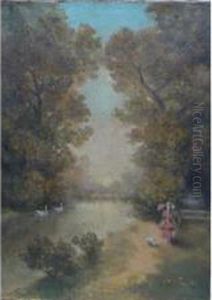John Pradier Paintings
James Pradier, often referred to as Jean-Jacques Pradier, was a distinguished Swiss-born French sculptor in the Neoclassical style. He was born on May 23, 1792, in Geneva, Switzerland. At a young age, Pradier moved to Paris, where he studied under the prominent sculptor François Joseph Bosio and also attended the École des Beaux-Arts. His talent was evident early on, and in 1813, he won the coveted Prix de Rome for sculpture, which provided him with the opportunity to study at the French Academy in Rome, Italy.
During his stay in Rome, Pradier was heavily influenced by ancient Roman sculpture and the Renaissance masters. After returning to Paris, he quickly established himself as one of the leading sculptors of his time. Pradier's works were known for their classical beauty combined with a sensual elegance that was characteristic of the Romantic movement, which was beginning to take shape during his career.
Pradier's sculptures adorned many public spaces and buildings in France. He is best known for his mythological figures, such as 'Saturn' and 'Venus', as well as his portrait busts, which include representations of many notable figures of his time. Pradier participated in the decoration of the Louvre, completed works for the Tuileries Palace, and contributed to the Arc de Triomphe. He also created the 'Fontaine de Léda' behind the Medici Fountain in the Luxembourg Gardens.
Apart from public monuments, Pradier also produced smaller works and was a skilled medalist. His work was in high demand among private collectors, and he exhibited at the Salon, the official art exhibition of the Académie des Beaux-Arts in Paris, where he won numerous awards.
James Pradier passed away on June 4, 1852, in Bougival, France, and was buried in the Père Lachaise Cemetery in Paris. His legacy lives on, as many of his sculptures are still admired today in museums and public spaces across France. Pradier's contributions to Neoclassical sculpture cemented his reputation as one of the foremost sculptors of his era.

